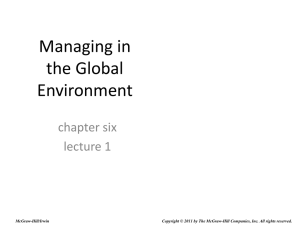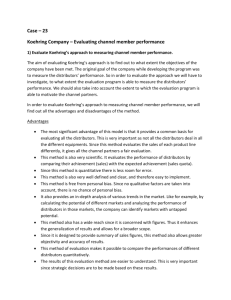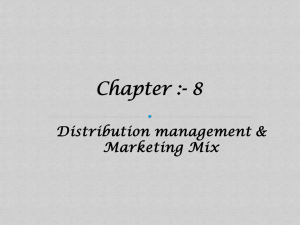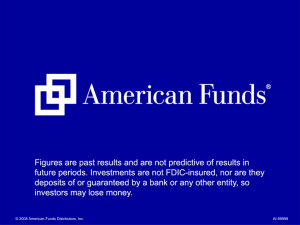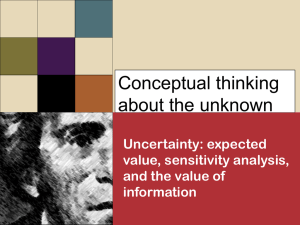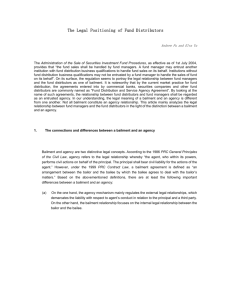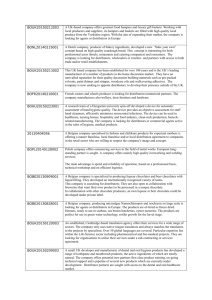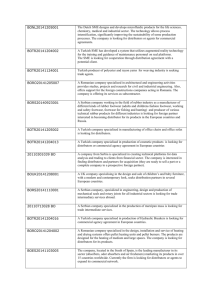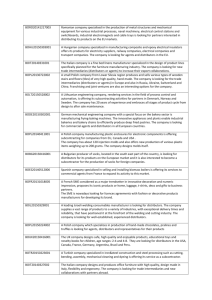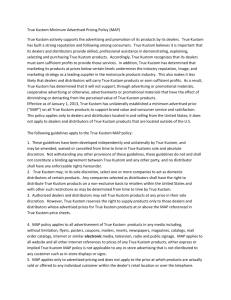Chapter 17 Script - Vanderbilt Business School
advertisement
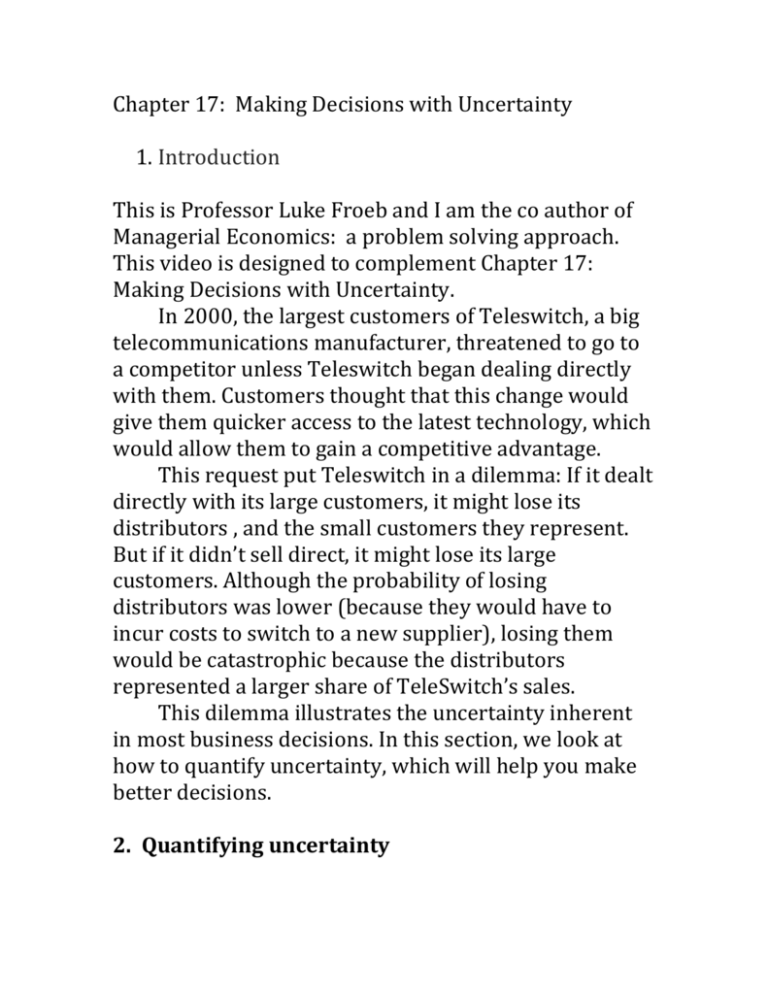
Chapter 17: Making Decisions with Uncertainty 1. Introduction This is Professor Luke Froeb and I am the co author of Managerial Economics: a problem solving approach. This video is designed to complement Chapter 17: Making Decisions with Uncertainty. In 2000, the largest customers of Teleswitch, a big telecommunications manufacturer, threatened to go to a competitor unless Teleswitch began dealing directly with them. Customers thought that this change would give them quicker access to the latest technology, which would allow them to gain a competitive advantage. This request put Teleswitch in a dilemma: If it dealt directly with its large customers, it might lose its distributors , and the small customers they represent. But if it didn’t sell direct, it might lose its large customers. Although the probability of losing distributors was lower (because they would have to incur costs to switch to a new supplier), losing them would be catastrophic because the distributors represented a larger share of TeleSwitch’s sales. This dilemma illustrates the uncertainty inherent in most business decisions. In this section, we look at how to quantify uncertainty, which will help you make better decisions. 2. Quantifying uncertainty Here is the big idea of the chapter: Instead of computing the costs and benefits of a decision (as we did in Chapter 3) we use random variables to quantify what we don’t know, and compute the expected benefits and the expected costs of a decision. To make this concrete, lets examine the decision facing TeleSwitch. Total company profit is currently $130 million, split between large customers ($30 million) and small customers ($100 million). <<ANIMATE THIS?>> If the firm sells direct <<DAVID, I KNOW THE DIFFERENCE BETWEEN AN ADVERB AND AN ADJECTIVE BUT “SELL DIRECT” IS A TERM OF ART IN BUSINESS. IN FACT, CAN YOU CHANGE “DIRECTLY” TO “DIRECT” IN THE FIGURE BELOW>> to large customers, they keep the large customers, but have a small probability of losing distributors, and the small customers they serve. If they don’t sell direct, they keep their small customers but face a big probability of losing their large ones. We diagram the consequences of the decision in Figure below, which is a simple decision tree with a lottery at the end of each branch. Telecom Firm Sell directly to large customers Sell only through dealers (.20) × $30 + (.80) × $130 = $110 (.60) × $100 + (.40) × $130 = $112 Distributors leave Distributors stay Large customers leave Large customers stay (probability = .20) Firm profit = $30 (probability = .80) Firm profit = $130 (probability = .60) Firm profit = $100 (probability = .40) Firm profit = $130 Look first at the left branch of the decision tree. <<DAVID, DRAW A BETTER DECISION TREE WITH THE PROBABILITIES ON THE TWIGS>> If TeleSwitch decides to sell direct, it faces a 20% probability that distributors will leave, in which case profit drops to $30 million. If distributors stay, profit remains at $130 million. The expected profit of going down the left branch is a $110 million. <<ANIMATE WEIGHTED AVERAGE CALCULATION>> Now check out the right branch of the decision tree. If TeleSwitch sells only through dealers, it faces a 60% probability that its large customers will leave, in which case firm profit drops to $100 million. If they stay (which has only a 40% probability), profit remains unchanged at $130 million. Selling only through dealers, has an expected profit of $112 million. <<ANIMATE?>> 3. making decisions under uncertainty So what should Teleswitch do? This is a close call. Just $2 million in expected profit separates the alternatives. It’s unlikely that the firm has estimated the probabilities precisely enough to distinguish between them. So, a third option presents itself here: TeleSwitch can gather more information by, for example, about the surveying large end users and distributors in hopes of estimating the probabilities more precisely. This would reduce uncertainty about what the probabilities really are, and result in a better decision. Doing the analysis explicitly like this clearly identifies the two separate risks that TeleSwitch faces. Another option is to try to find a way to mitigate the adverse consequences of the risk. For example, perhaps Teleswitch could find a way to retain its dealers, even if it does deal directly with large customers—perhaps by giving them a cut of the profit from large customer accounts. Or TeleSwitch may be able to prevent large customers from leaving if it sells only through dealers— perhaps by providing large customers with in-house company-trained technicians. 4. BOTTOM LINE: We have seen that trying to quantify uncertainty has three advantages: First, by presenting decision makers analysis that accounts for uncertainty, you alert them to the riskiness of the decisions and show them how to compute the do benefit-cost analysis with expected values. Second, this kind of analysis identifies the sources of risk and may suggests ways to mitigate risk. The final reason for doing this kind of analysis is that it gives you an excuse if things turn out poorly. You can correctly say that you foresaw the risk, quantified it, and reached the best decision using expected benefits and expected costs. But making good decisions does not mean that you will always make money. The final benefit of modeling decisions using random variables is illustrated with a simple example. Suppose your colleague invites you to invest in a real estate venture. He gives you a prospectus that shows how much money you’ll make if you invest. The prospectus is based on estimates of future interest rates and future housing demand in the area. How should you analyze the prospectus? If you’re uncertain about the future, you need to rework the analysis using best- and worst-case scenarios. You have two sources of risk here—both future demand and future interest rates, which may be related—so you should rework the analysis on a spreadsheet, allowing you to vary the assumptions about the future. Your colleague has most likely given you a bestcase scenario (low interest rates/ high demand). Add other scenarios (low interest rates/low demand, high interest rates/high demand, high interest rates/low demand), and assign probabilities to each scenario. Compute profit under each possible outcome, and calculate expected profit as the weighted sum of the possible outcomes. Here is what you will learn by doing this. Almost certainly, your colleague will do well under all four scenarios; you, however, will do well under only under the favorable scenario. Don’t invest, or ask him to re-structure the deal so that his incentives are more closely aligned with your profitability goals. For example, design the deal so he gets a share of the profit only after you receive an 8% return on your investment. If your colleague declines, then most likely he doesn’t believe his own forecasts.
